A Complete Guide to Online Pharmacy App Development

Do you also hate standing in long queues to buy medicines in conventional pharmacy outlets? I bet you do. It is time-consuming, and boring, and leads to customer dissatisfaction in case of low medicine stock. Here’s where an Online Pharmacy App comes into play.
e-pharmacy is an online pharmacy through which you can order and receive requisite medicines anywhere and anytime, without having to physically visit a drugstore. Because of the convenience it provides, the increasing prevalence of the Internet of Things worldwide, and the growing use of smartphones and tablets, these apps are becoming extremely popular among end users.
Moreover, the worldwide pandemic brought an exponential transformation in the field of online medical services, and that has augmented an upsurge in the subsequent development, progress, and popularity of online pharmacy app development.
Let’s support this with some market facts:
- According to Market Research Future, the global epharmacy market was valued at USD62.59 billion in 2019 and is expected to grow at a CAGR of 12.5% between 2020-2027.
- This sector is experiencing a healthy growth due to lockdown restrictions and social distancing norms imposed during the COVID-19 pandemic.
- Further, rising incidences of chronic diseases, increasing awareness about the benefits of online pharmacies, and an increase in the implementation of e-prescriptions are some of the factors contributing to the exponential growth of this sector.
- The prescription drugs segment accounted for the largest share of almost 60% in 2019.
- North America (primarily, the U.S.) has the largest share of the e-pharmacy market fueled by rapid population growth and high adoption of e-commerce.
- Asia-Pacific is expected to have dominance in the coming years led by the rapid penetration of cloud based technology & high speed internet, increasing per capita income, rising population in countries like India & China, and government initiatives to improve the quality of healthcare.
- Europe too holds a substantial share in the global ePharmacy market. The Middle East & Africa are catching up.
Now let us dig deep into the details of online medicine delivery app development. We’ll learn:
- Benefits of Online Pharmacy Apps
- Business Models to Consider Before On-Demand Medicine Delivery App Development
- Basic Functionalities of Medicine Delivery Apps
- Advanced Features of Medicine Delivery Mobile Apps
- 10 Steps to Develop an Online Pharmacy Application
Benefits of Online Pharmacy Apps
Online pharmacy apps provide ample benefits to both – Customers and Business Owners.
Benefits for Customers:
1. Privacy
Some customers hesitate to purchase certain drugs at a local store in front of others. With an on-demand medicine ordering & delivery app, it is much easier for them to maintain their privacy.
2. Saves Time
Many times, a patient finds it difficult to get some medicine at a local store and has to spend a lot of time & effort to find it at other stores. With an on-demand medicine app, there’s no such hassle.
3. Competitive Prices
Online medicine ordering & delivery app solutions by branded pharmacies offer lucrative promos or; discounts to attract customers, which otherwise is not available at local chemists. As a result, users get the most competitive pricing for their medication.
4. Contactless Doorstep Delivery
Medicine pharmacy apps add to the convenience of users with the option of home delivery for medications. This became the biggest support system in the time of COVID-19. when people were scared to step out but could place contactless orders online and get contactless delivery of medicines straight to home.
Benefits for Owners:
1. Helps Build a Loyal Customer Base
On-demand pharmacy delivery apps provide a seamless buying experience to their customers from placing orders to delivery. Hence saving them the effort to visit a drugstore. Further, such apps enable pharmacy owners to have direct interaction with their customers and work on the feedback received. Incorporating such customer requirements, offering discounts, sending reminders for prescription refills, etc. helps them to gain customer loyalty, thereby getting repeated orders.
2. Increases Customer Reach
This is true for any online business. With an online platform, you will be able to expand your business by offering services to customers at far-off places.
3. Better Inventory Management
With an online medicine ordering & delivery app solution, pharmacists do not have to manually update their inventory levels. Because orders are processed online, the stock is automatically adjusted in the backend after every sale. Further, advanced systems also alert owners for re-orders, approaching expiry dates, etc.
4. Opportunity to up-sell
By studying the customer purchase patterns, pharmacies are able to recommend to patients some lab tests or other common medicines (say, antacids, vitamins) which can be taken with doctor-prescribed heavy-dose medication. This gives them an opportunity to up-sell their products. For example, a customer buying Hyperglycemia medicines can be suggested to take a Glucose Test at the comfort of his home. However, prior to this, the pharmacy should either have an in-house lab or be partners with third-party laboratories.
5. Brand Establishment
Mobile apps have proven to be an effective marketing tool for any business by pushing a brand through push notifications, news, promotions, and offers. It also helps you generate feedback and study user patterns (like most liked features, medicines in demand, etc.) to better manage and improve shortcomings or errors in services, thus improving the overall image of the brand.
Business Models to Consider Before On-Demand Medicine Delivery App Development
Thinking about how to begin with online medicine delivery app development? It is important to understand all e-pharmacy business models before choosing the right one for yourself.
A) Individual Stores
Under this setup, customers place their orders with online retailers by uploading their prescriptions. The retailers then check for the availability of the products and send them to their customers. The users can then make the payment of the medicines online or offline. For example: Rite Aid, CVS Pharmacy, etc.
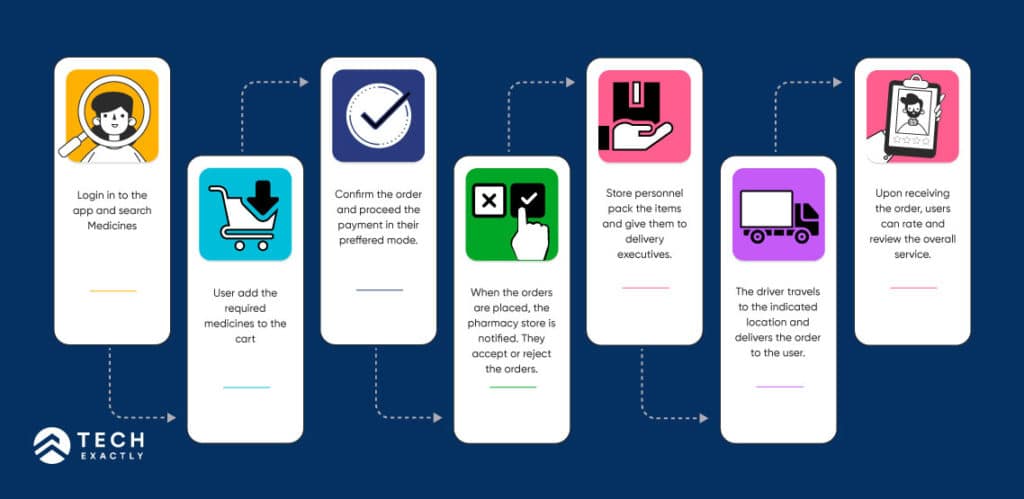
B) Medicine Delivery App for Aggregator
Under this model, the online pharmacy owners tie up with the local drugstores in multiple areas, instead of maintaining their own inventory of medicines. Once a user places an order in the app, the e-pharmacy checks for the ordered product’s availability in the partnered drugstore nearest to the customer and redirects the request to the same. The local chemist then completes the chain by manually delivering the medicines to the user. For example: Optum Rx, Now RX, etc.
C) Direct to Consumer
This model helps the medication delivery app to avoid any intermediary for the delivery or supply of the medicines. Pharmacies directly deal with and complete order requests themselves. Reaching out to customers directly helps business owners to have better control over their businesses.
Basic Functionalities of Medicine Delivery Apps
To provide the best customer experience, it is essential to make a feature-rich app. Let us throw some light on the basic and advanced features for various users:

1. Customer App:
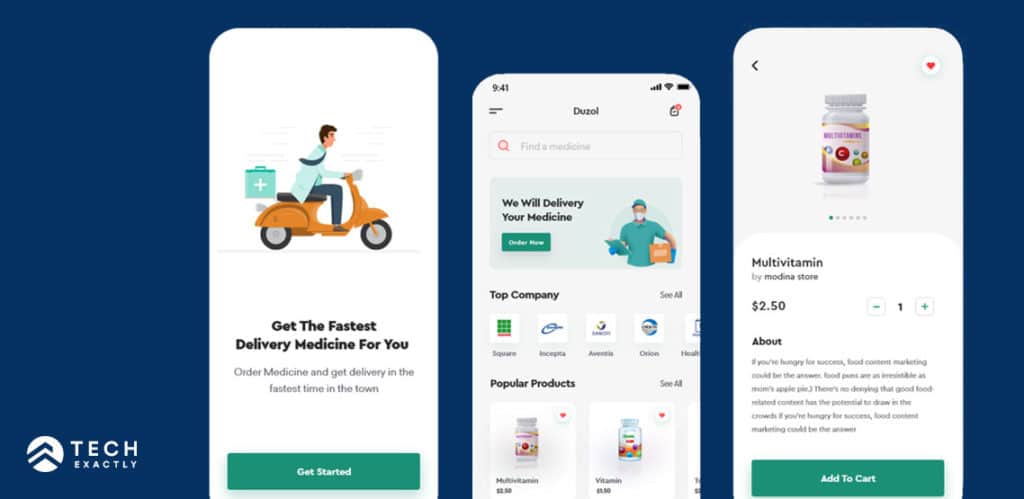
-
Login & Registration
Allow users to sign up via email, social media credentials, or phone number. -
Smart Search for Medicines
Define advanced search, sorting & filtering options based on customer problems, frequently asked questions, etc to enable users quickly find the required drugs. -
Drug Information
Your drug database should have detailed information for all medicines like manufacturers, price, dosage, possible side effects, drug image, and expiry date and it should be easily accessible to users. -
Product Comparison
With this, users can compare products from different manufacturers including price, customer reviews, etc. And accordingly, make a wise decision. -
Substitute Suggestion
Many times, the required drug is either unavailable or too expensive. Hence, a suggestion for its substitute comes in handy. -
Upload Prescription
Enable users to upload a copy of their doctor’s prescription in the app. This will make it easy for users to order medicines and will serve as authentic evidence that medicines have been prescribed by a licensed doctor. -
Order Online
Make ordering hassle-free by allowing users to easily edit their shopping carts and make the final purchase. -
In-App Payment
Provide secure payment gateway by integrating various payment models like credit/debit cards, mobile e-wallets, COD, etc. You may also offer promotional codes and loyalty programs to your users to build a strong customer base. -
Real-Time Order Tracking
This will help the users to know the status of their orders. You can use tags like ‘order received’, ‘in progress’, ‘out for delivery’, ‘delivered’, etc. -
Refill Prescription
For the ultimate user experience, allow patients to reorder prescriptions from order history with just one click. -
Notifications
In-app notifications can be used for order confirmation, new trending products, latest offers & discounts, previously unavailable looked for drugs now available, alerts for drug refills, etc. -
Contact Store
This will allow the users to get in touch with the drugstore for any queries and clarifications. -
Pill Reminder
Another highly appreciated feature is to remind your users to take their pills. -
Return Policy
Users should be able to place a return or replacement request in cases like receiving a different product from what’s ordered, receiving a defective item, the ordered item is past its expiry date, the order is lost in transit, drugs not required anymore, etc. -
Newsletters/Articles
To provide a complete package, you can share the latest health news, fitness tips, trending products, and other health-related information with your users. -
Feedback
Users should be able to share their experience (good or bad) or complain about the quality of service, from say a particular pharmacy, right from the app. -
Multi-Device support
Such apps should be versatile, universal, and operational in all types of Android and iOS devices.
2. Medical Store/Pharmacists Web Panel:
-
Login and Registration
The pharmacists should be able to log in using their allotted personal credentials (User Name & ID). Next, information like Name, Age, Address, Employment ID, and other related details should be filled in. -
Drug Details
A pharmacist should be able to view all details about all the products which will help him resolve customer queries, suggest substitute medicine, etc. -
Notification
Notify the store upon receipt of a new order, successful/unsuccessful delivery of an order, payment received, etc. -
Prescription Checking
Upon receipt of an order, the pharmacist should be able to view the supporting digitized prescription uploaded by the customer. -
Order Management
Under this panel, the store staff should be able to arrange the order, manage returns and refunds, payment status, and many more. Further, based on the current status of the order, the system should automatically update the order status using tags like ‘order received’, ‘in progress’, ‘out for delivery’, ‘delivered’, etc for the customer’s knowledge. -
Order History
The system should keep a record of all past, present, scheduled, and canceled orders for future reconciliation & reference. -
Billing
Allow pharmacists to raise a bill for each order. -
Track Payment
Allow the store to know the payment status against each bill (paid online, to be paid on delivery, due for payment, etc.) -
Shipment and Delivery
After the order is ready for dispatch, the staff will assign it to a partnered courier service and update details like the name of the courier service/delivery boy, tracking number, distance, weight of the package, etc. Also, enables the store to track the delivery status of all its courier requests. -
Customer Support
Allows pharmacists to immediately resolve customer queries important for customer loyalty and retention. -
Contact Admin
Get in touch with the admin team for any queries or updates.
3. Admin Web Panel
-
Login and Registration
Just like any other user of the app, the admin team should be able to log in securely and also be able to change their passwords, whenever needed. Moreover, it is important to verify the identity (say, with the help of a unique ID, or OTP) & track the activity of each user. -
Dashboard
With a dedicated dashboard, you can at a glance monitor and control all the operations of the medicine delivery app, which is being simultaneously used by various people. It must include information like pending requests, stock expiry, restock level, customer complaints, etc. -
Admin Team User Management
Assigning access to various modules of the admin app should be in accordance with the role/position of different groups of users in the admin team. Similarly for privileges like View, Create, Edit, Delete record. -
Manage Customer Orders
Admin should know the status of all new, in progress, scheduled for future orders. Further, under this module, there should be a record of all details of past, complete, and canceled orders including customer name, order details, time taken to complete the request, delays or complaints, if any, customer ratings, etc. -
Inventory Management
Enables you to have a real-time update of stock at all its stores. Should include functions like detailed information about each medical product, manufacturer details, set reorder level, approaching expiry date, etc. -
Supplier Management
Lists all the suppliers/manufacturers you have tied up with including name, address, contact number, past orders, etc. -
Manage Supplier Order
Based on the inventory level, you should be able to place orders with your suppliers and include information like the name of the product, description, delivery address, urgency, if any, etc. Further, all orders should be recorded in the backend for the future. -
Price Management
Based on market demand and supply trends, you should be able to roll out discounts and offers and accordingly make revisions on the prices of the products. Discounts and offers could be on individual medicines, consolidated orders, etc. -
Marketing
This function helps the admin to manage advertising, marketing campaigns, promos and offers, etc. -
Monetization
Takes care of all the strategies adopted by you to monetize your app. -
Reporting and Analytics
Analyses each module, processes data, and provides reports for data-driven decision making by the management of the company. -
Notifications
Receive alerts and notifications for say, restocking medicines, escalations, messages from its store, etc. You should also be allowed to send custom alerts to both stores and customers. -
Complaint Management
All complaints & queries raised by various users of the app must be clearly visible to the admin. This will help you understand & work on existing loopholes, respond to queries, and even resolve them. Overall, it will improve the quality of your business. -
Contact Store
Allows users to contact its retail stores.
4. Delivery App:
-
Login & Registration
The driver’s app must have all the necessary personal details of drivers like name, address, contact number, driver’s license number, etc for record. -
Alerts and Notifications
In-app notifications can be used to alert drivers for new delivery requests, which should include all information like customer name, delivery address, contact number, alternate contact number, payment details, etc. -
Route Guidance
AI- supported route guidance will help to deliver the order in the shortest possible time. -
Quick Communication
Enables drivers to quickly contact the customer with just a click in the app. -
Delivery Status
The delivery status of each order should be immediately updated in the app by the delivery person. It could range from delivered, denied at delivery, delivery delayed, etc. In case, the customer has opted for cash on delivery, payment received on delivery should also be updated in the app. -
Performance History
Records all assigned orders and includes details like product names, delivery address, date of delivery, time taken to complete the order, customer details, etc. -
Ratings and Feedback
Motivates an individual to fill the gaps in his service and perform better. Higher customer rating might also lead to higher incentives. -
Multi-platform support
Such apps should work flawlessly on all kinds of iOS & Android devices for an effective working mechanism.
Advanced Features of Medicine Delivery Mobile Apps
For a truly innovative, valuable, and customer-centric approach, you may consider incorporating the following advanced features:
-
In-app Consultation
You may provide an opportunity to your users to either book an appointment with a doctor from your app or get in touch with an expert immediately on any symptoms, medication, or any other concern.
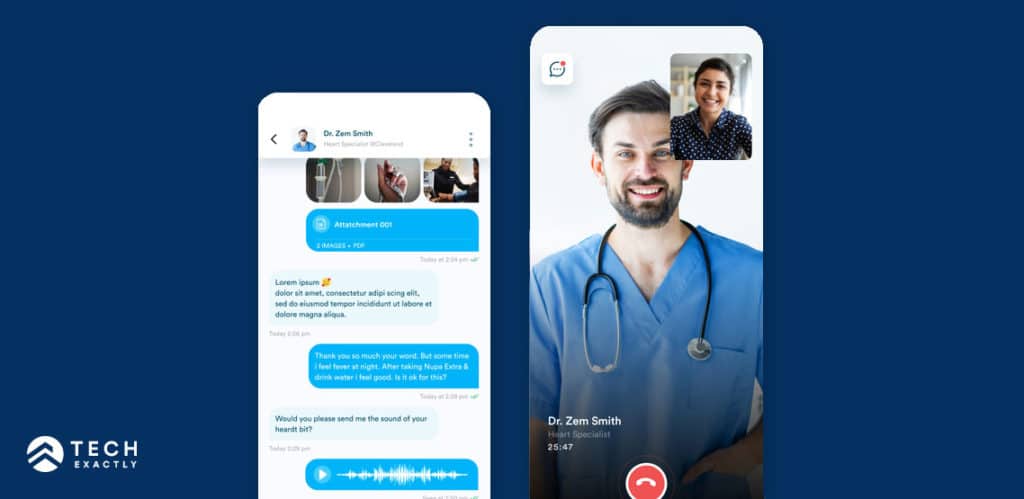
-
Lab Test Bookings
Similarly, you can offer your customers to schedule lab tests and diagnostic check-ups at a better price right from the app.
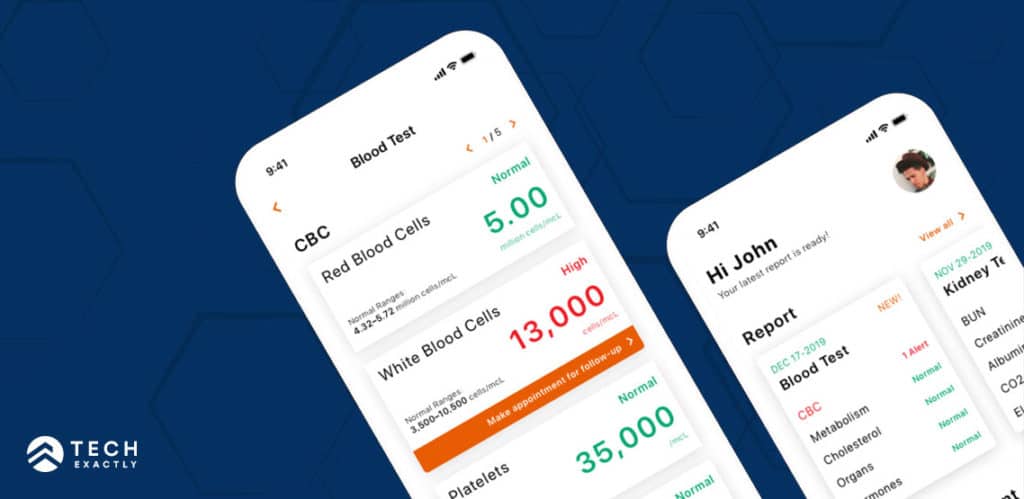
-
Share Electronic Health Records (EHR)
For more convenience, allow your users to share digital medical records like lab test reports, previous prescriptions, etc with doctors, labs, or emergency facilities. To ensure data security, the system should be designed in a way that healthcare professionals obtain authorization prior to accessing such documents.
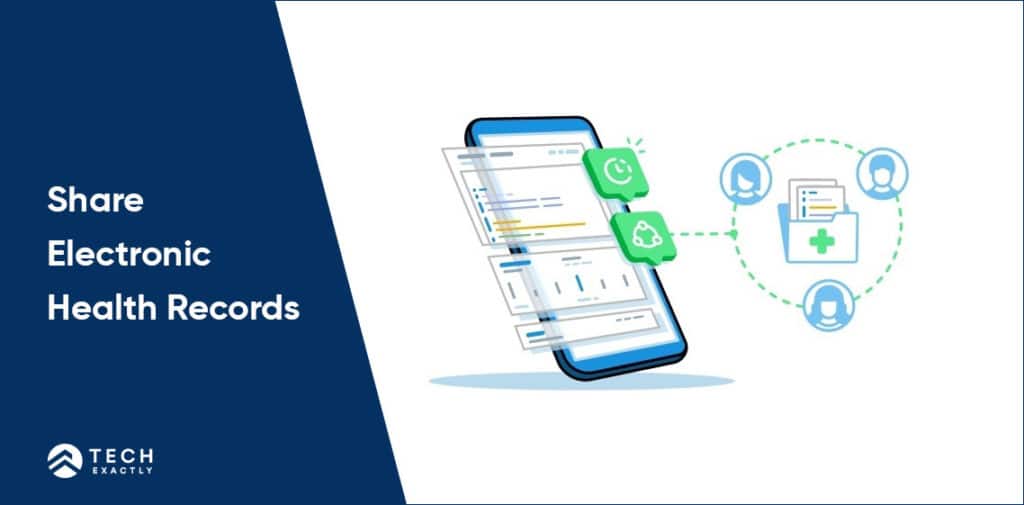
-
Multi-Language Support
Scale up your business and make your app universal. There can be multi-currency and multi-weight unit converter (like lbs to kg and vice versa) features. However, be mindful to check the legislation in advance for a smooth operation of your online pharmacy app. -
Local Store Search
Sometimes a user might have to visit a local drugstore for say, a demonstration on how to use a device or buying medicine urgently, etc. In such cases, this feature may help to locate nearby pharmacies or diagnostics centers. -
In-App Scanner
An in-built scanner can help users upload their physical prescriptions or test reports in the app. -
Photo Prescription Recognition
This feature, when powered by Artificial Intelligence(AI) will help to automatically add medicines to the cart by reading handwritten prescriptions. -
Chatbot Support
This automated customer support system can enable users to immediately get in touch with support staff in case of any queries.
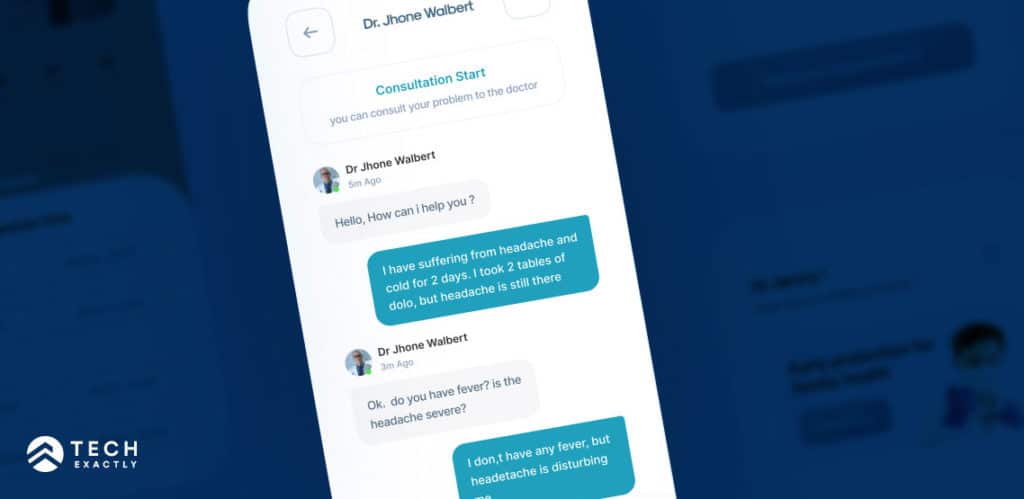
Cost to Develop a Pharmacy Delivery App
The next obvious question in your mind is the cost involved in developing such an app. Honestly, just like any other app, determining the cost to develop a pharmacy delivery app depends upon a number of factors. Some factors that play a pivotal role are:
- Number of platforms you want to release your app in.
- Required set of features in your application
- App design – the more complex your design is (say, animations), the more you pay.
- Some customized features may require integration with 3rd party platform APIs which hikes the cost of pharmacy delivery app development.
- Tech Stack – Native or cross-platform, Laravel, Python, Twilio, Push.io, Nexmo, AWS, Google, Azure, HBase, Cassandra, Postgres and MailChimp Integration, etc.
- Whether using advanced technologies such as AI and Machine Learning.
- Expected timeline to build your app
- The location of pharmacy app developers also matters. For example – generally speaking, developers in the USA charge more than Indian developers.
- Size of the development team
To give you a ballpark figure, the minimum budget for a healthcare mobile app development should be around $60,000 for a single platform, which can go up to $500,000 or even more.
10 Steps to Develop an Online Pharmacy Application
A top-notch online pharmacy app needs step-by-step development right from a minimum viable product to a full-fledged application. Let’s dive straight into it:
Step-1: Study your Competitors
It is imperative to know what’s available in the market and create innovative solutions that satisfy your target user’s needs. Start from scratch by defining who your end users are, what they expect from an app & how they want to use it.
Study your competitors & the services they offer. Look for customer reviews & comments on such apps and see if the competitor is missing out on something that customers desire. This provides you a lucrative opportunity to offer something new and desired and hence is a great way to build brand popularity.
Step 2: Build a Rough Layout
After choosing the right model for yourself, it’s important to deeply analyze and have detailed discussions about it with technical and design experts. Define broad layouts, feature lists, and other intricate specifications that will act as a roadmap in your online medicine delivery app development journey.
Step-3: Prototyping
Most successful mobile apps have adopted the procedure of releasing a prototype or beta version of the apps that they design. These prototypes are released for use over a limited period of time and help in generating crucial feedback. This helps to save you cost & time and moreover, build a better liked product for your users.
Step-4: List down Functionalities
In customized app development, you can choose the innumerable features to add to your product. A feature-rich yet simple application can help you meet user requirements better.
Step 5: Attractive UI & Simple UX
A successful pharmacy delivery app needs an intuitive & attractive design responsive to the latest UX/UI trends in the market and a user-friendly interface for the customers to access the app easily.
Step 6: Compliance with Data Protection Regulations
Data security is of utmost importance in any healthcare app. As the pharmacy delivery app deals with sensitive information, like personal health information, payment credentials, etc. It must comply with the rules and regulations applicable within the regions it is catering to, such as HIPAA, FDA, GDPR, etc.
Step-7: Backend Development
This is rather a delicate stage of pharmacy app development. It involves building the server side of the application.
Step 8: App Monetization
Well, a genuine ask for an investor would be to make profits out of his app. To make your mobile health app more rewarding and to increase your customer base, you may use any of the monetization strategies that are ruling the healthcare market. This includes charging users for premium features of the app, in-app advertisements, in-app purchases, gamifications, etc.
You can read more about this in our article on 9 Full-Proof Strategies to Increase Mobile Medical Mobile App Revenue & Customer Base.
Step-9: Testing & Maintenance
It is important to thoroughly test your product to fix bugs, frequent crashes, long loading times, technical glitches, etc. Because these can pull your app back in the race, you need to have experts who will constantly upgrade/add features on the basis of user feedback, market innovations, etc.
Step-10: Launching the App
Developing an app is not enough. Launch the app successfully on the app stores for users to see & download it.
Create your own app with us!
Tech Exactly has developed a surfeit of accomplished, customized, and feature-rich mobile healthcare applications over the years. Partnering with us, you get a dedicated team who have the expertise to understand your needs for an effective medicine app development solution which will help you stand apart from the crowd and gain an edge to transform your dream into reality. Right from conceptualization and strategy analysis to designing, development, and release, we assure quality and work hand-in-glove to provide end-to-end support at every step of your digital journey.
